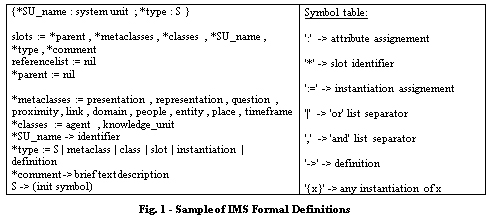
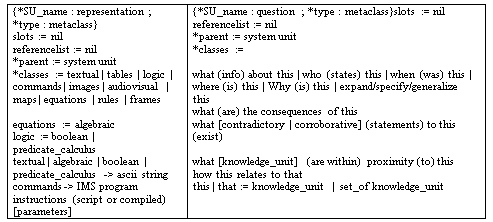
Fig. 2 - Sample of IMS Formal definitions
To quote this paper:
Ferraz de Abreu, P., Joanaz de Melo, J. (2000), "Introducing New Information Technologies in Public Participation: Technology is the Easy Part", in Public Participation and Information Technologies 1999, CITIDEP & DCEA-FCT-UNL, Lisbon, Portugal. 2000. 600 pages, pp 393-405 |
The first steps in using Internet as a legitimate channel for public participation in environmental impact assessment (EIA) in Portugal occurred on the occasion of the Valorsul proposed incinerator for urban solid waste. With the support of all intervening actors (Ministry of Environment, Valorsul, Environmental NGOs, local citizen's committees), CITIDEP put forward the IMS Project (Intelligent Multimedia System in support of expert review and public participation). IMS and Internet together were used and tested during the official period of public participation. IMS was also essayed with students from undergraduate programs (Environmental Engineering at the New University of Lisbon and Psychology at the University of Lisbon), as part of practical course work. In this paper we describe key components of the experiment and discuss some of its results (which include some expected and unexpected obstacles and performances), concerning the role of this technology for different kinds of audiences and actors, and the regulatory and institutional context. Supported by these results, we argue that regulatory framework and institutional culture is the "hard part" of the equation PPIT. We contend that Internet-based exchange of information on EIA cases should be promoted and regulated as mandatory to the extent allowed by existing technology, given its irreplaceable role in public participation.
In the early 90's, serious confrontations took place in Portugal, between the Environmental Administration and citizens from candidate sites for a hazardous waste incinerator, confrontations that resulted among other things in the physical impossibility of environmental impact assessment (EIA) teams to complete their work. These events, some times violent, contributed to an emerging interest from the Ministry of Environment towards the use of new information technologies (IT), in the hope they could contribute to a less emotional debate and a more persuasive way to convey technical arguments to the public in general. On the other hand, environmental non-governmental organizations (NGOs) were also eager to use the new IT and IT-based tools to facilitate and increase the role of public participation in the overall process of decision-making, particularly during EIA reviews. Consequently, and while with different expectations, the drive to introduce new IT in public participation gained general support.
In this context occurred (in 1996) the first experience in Portugal of incorporating the use of Internet in the EIA review process, together with multimedia tools in support of public participation: the IMS Project.
The IMS (Intelligent Multimedia System) project was part of Pedro Ferraz de Abreu's Ph.D. thesis research at MIT, USA, and supported by the recently born CITIDEP (Research Center on Information Technologies and Participatory Democracy). João Joanaz de Melo was a leading researcher in the "Expert Panel" created at CITIDEP to support the IMS Project. The proposed methodology was to test the introduction of a specific set of new IT (an advanced multimedia software prototype, together with Internet-based tools), in the EIA review process of a particular case. The adopted case study was the EIA review for the Solid Urban Waste Treatment Station (incinerator) projected for S. João da Talha, Portugal. The experience had both a technological analysis component (advantages and deficiencies of the new IT put in evidence by its use in real conditions) and a process analysis component (advantages and difficulties in integrating the new IT in current processes, and hypothesis of innovative processes of public consultation made possible by the new IT).
For comparative and control purposes, we also tested IMS with students from undergraduate programs (Environmental Engineering at the New University of Lisbon and Psychology at the University of Lisbon), as part of practical course work.
As early as 1994, the core technology was available, and the Minister of Environment expressed her full support to the IMS Project. IPAMB, the Environmental Agency in charge of public participation in EIA reviews, was very receptive from the beginning, as was a major Portuguese University (UNL). However, only by December 1995 was funding made available for the case study, through a cooperation protocol between the Directorate-General for Environment (DGA, an agency under the Ministry for Environment) and the Department of Environmental Sciences and Engineering of the New University of Lisbon (DCEA-FCT-UNL). In a way, this delay was a premonitory hint that technology was not the hardest component of this endeavor.
A more thorough description of the problems addressed by the IMS Project, of the IMS itself, as well as the preliminary findings of the project, can be found in other articles (Ferraz de Abreu and Chito, 1997) and reports (Ferraz de Abreu, 1998, Ferraz de Abreu, 1994). In this paper, we describe the Lisbon's incinerator case and the general settings of the IMS experiment, focusing in particular on the test of usability of the technology, and in the contrast with the difficulties arising from the institutional and regulatory framework.
The city of Lisbon has had problems with urban waste management and disposal for a long time. Urban waste has been dumped in an old-style sanitary landfill (not even complying with current regulations) at Beirolas, on the northeastern tip of Lisbon municipality, an old industrial area.
By 1992, a project was put forward by the Portuguese Government to host the 1998 World Exhibition, on the northeastern part of the city, facing the Tagus estuary. This proposal was approved by the international committee from several applications. The exhibition was called Expo'98 and was managed by a state-owned company called Parque Expo.
Although the Expo'98 occupied only about 100 ha, the project called for the cleaning up and reclamation of an "intervention zone" of some 310 ha, a land strip with 3 km of river front, containing some of the most heavily polluted soil in Lisbon, including the Beirolas landfill and a number of other polluting sources, such as a slaughter house, old industrial and harbor facilities, fuel storage tanks and an old oil refinery. An alternative location had therefore to be found for all facilities still operating in the "intervention zone", including the urban waste disposal. Alternatives had to be operating by 1996, allowing the area to be completely cleaned up, erased and rebuilt for the Expo'98 event.
In view of this situation, Lisbon and three other municipalities (Loures, Amadora and Vila Franca de Xira), representing about a million and a half inhabitants, teamed together with Parque Expo to build a multi-municipal urban waste incinerator. This should be in full operation by early 2000, the waste being sent in the meanwhile to a temporary sanitary landfill at the site of Mato da Cruz, in the municipality of Vila Franca de Xira.
This was considered a key project regarding public consultation, for a number of reasons:
- A definitive solution was urgent, because the old landfill was sealed in view of the Expo'98, the temporary one has a small capacity, plus European funds for the project might be lost if there was no swift action. Therefore, there was a high pressure for the advancement of the project. To a certain extent, this may be considered a solution to a difficult environmental problem;
- Waste-related projects are always highly controversial. Waste is perceived as something bad, people do not like it, hence the NIMBY syndrome (Not In My Back Yard) is rampant among potentially affected populations, irrespective of actual impact. Local populations were mobilized against the project;
- Furthermore, environmental impact may actually be quite relevant in this case, because the indiscriminate burning of waste may result in significant pollution and public health risks, in a densely populated area;
- Critics point out that the absence of alternatives is linked to the absence of a coherent policy on waste reduction and waste management at both municipal and national level.
In short, many people were highly motivated to discuss the issue, including local populations, local and national authorities and environmental NGOs; there were strong arguments, both political and technical, pro and against the project; part of the information was highly technical and not readily available to the general public; and the environmental authorities were making an effort to improve exchange of information on major projects. This setting made an ideal case study for the approach and the technology proposed by IMS.
The two IMS Project's major components were the use of Internet as a formal resource of the public consultation process (a mandatory part of the EIA review process), and the use of an advanced software prototype as an informal resource for both experts and public in the same process.
On the Internet, and for the first time in Portugal,
On Macintosh computers, installed at the Ministry of Environment (IPAMB, DGA, DRA-LVT, SEA), at CITIDEP, at DCEA-FCT-UNL, and at Environmental NGOs (GEOTA, LPN), the Intelligent Multimedia System (IMS) prototype, with:
Each pair question-answer, either on the Web or on IMS prototype, had a "technical complexity" classification flag: red for complex, demanding expert knowledge; green for simple, non-expert (lay) material, and yellow for border line cases. In addition, each question suggested which other questions were a logical continuation of it. This means that the user could follow a sequence or "trail" of question-answer pairs at different levels of difficulty; for instance, to follow a "green" trail, and only chose to go in-depth to the "yellow" or "red" trail in some specific issues.
The process of pre-compiling and selecting the referred questions, using the FAQ model was achieved by CITIDEP "IMS Expert Panel" and was in itself an interesting experiment; since we were compiling them "a priori" and did not obviously have the "F" data, it is significant that most of those questions were considered relevant by all the system users "a posteriori" (Ferraz de Abreu, 1998).
The IMS software prototype incorporated several advanced concepts, from artificial intelligence (knowledge representation, inference engine, inheritance), multimedia databases (video indexation, metadata) and interactive interfaces (drag and drop, contextual help). Having in mind testing the usability of such technologies, special care was given to formal definitions (Fig. 1 and 2) and "tracing" devices, allowing some measure of the user behavior and performance.


Fig. 2 - Sample of IMS Formal definitions
The "core" of the IMS prototype was the "Virtual Office Area", with experts available on call by the user (Fig. 3 and 4).
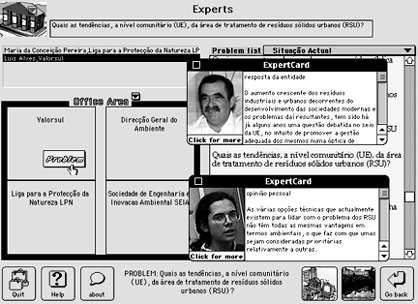
The user identifies a question matching his/her concern, and by selecting such question the system performs a real-time search on its multimedia, modular data-bases, collecting in the process all the related information and data files, including the number of experts (and their affiliations) that provided an answer to such question.
The IMS prototype uses that information to generate, in real-time, a "Virtual Office" for each expert available for that question. The user is now free to take the problem to his/her choice of expert (either literally dragging it and dropping it in the expert "office", or by clicking the "office"). This allows the user to check in parallel several summary opinions from different actors in the process (Ministry, Developer, EIA Expert, NGOs, etc.).
IMS allows the user also to choose more detailed multimedia information from each one of the experts (using the "click for more" button on each "Expert Card", Fig. 4). This means the user has a choice of either explore superficially multiple issues, or to go more in depth on any particular issue.
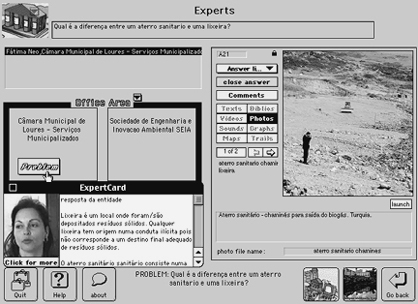
Other functions are available in the prototype, such as an expert system, a multimedia browser, a mail central (Ferraz de Abreu, 1998)
Expectations of Internet use during the EIA review were from low (Valorsul) to moderate (IPAMB), since the population of the site in question was predominantly workers from local industry, unlikely to have access to Internet. Consequently, the Internet component of the IMS Project was seen as targeting more students and environmental motivated citizens. In fact, maybe in consequence, there was no major effort to publicize the Web site, from any of the intervening actors: even a press conference from the Ministry of Environment to announce the use of the new IT occurred just a few days before the end of the public consultation legal period.
Either in result of this lack of publicity, or as a confirmation of these models of expectations, the number of visits during the period of public consultation was low (213), and roughly equivalent to the number of participants in the public audiences. Considering that several of those page hits could be from recurrent visitors, the probable number of visitors was even less.
Even less significant was the number of emails received by IPAMB (around a dozen), with only three opinions published on IPAMB web page. However, the lack of information about this email channel was not the only factor in presence, in this case. Considering that the current law made only acceptable citizen opinions in writing, and that it was not explicit anywhere that email could be considered a form of written participation, IPAMB decided not to accept any email as a legitimate part of the review process. The main reason indicated was the fear that such act could be used to question in court the legal validity of the EIA review, with all negative consequences (delays, costs).
Therefore, on one hand we had the IT ready and available, and the political will to use it; on the other hand, we had an inadequate legal framework, and the predominance of a reactive, defensive institutional culture.
The experimental data seemed, therefore, inconclusive in regard of the usability of Internet in EIA review. However, an unexpected phenomenon was observed after the public consultation period: the number of visitors to the web site continued to grow, near exponentially (Fig. 5), despite the fact that, for legal purposes, the web pages were obsolete.

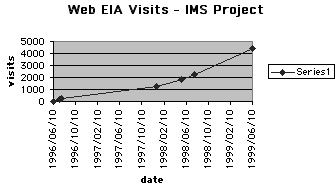
Moreover, the CITIDEP IMS team continued to receive many queries, from students, journalists and other interested citizens, as well as answers to the on-line survey. For these visitors, the data had current relevancy, and their responsiveness demonstrated the usability of the system, "a posteriori".
It also shows that Web-based information has a longer life span than other media; the peak of attention on TV, radio, meetings, was of higher intensity than the one on the web during the public consultation period, but in all of those media it died shortly afterwards -- with the exception of the web. In our view, this demonstrates a useful and irreplaceable role of Internet-web-based EIA information.
However, who pays for it? It is significant that it was Valorsul, the promoter, and not the public administration (Ministry of Environmental) that funded the web site, and kept it on-line until now with EIA detailed information, years after, and long time after all related information was erased from IPAMB web site. Web publishing is a resource that has costs, as any other resource. In this case, the funding existed in an opportunistic, exceptional mode: a propos the IMS Project research. Without a clear commitment from public administration, and corresponding clear regulation on who will be responsible to promote and fund such web publication, it is unlikely that it will happen again. In fact, we know of only one similar initiative planned since 1996: the proposed new Lisbon airport (among several hundred EIA reviews made since our case study).
In regard to the IMS prototype, its use occurred with the same kind of restrictions the Internet component had: lack of publicity, low to moderate expectations of user numbers. However, another factor deserves our attention: the difficulties faced by the IMS Project team to collect the EIA documents in digital form.
Since consultants type their documents in computers, it does not make any sense to waste considerable time and money to digitize thousands of pages and images from a printed version; but we were forced to a large volume of typing and scanning, and the documents in digital form we received only arrived many days later, after the deadline. The apparent reasons were several; from reluctance of the EIA consultants to provide their digital source documents, requesting in some cases special written instructions from Valorsul and despite verbal confirmation that Valorsul authorized and supported our work; to the difficulties in gathering the digital files, distributed among many individual computers in unknown places, given the absence of a single media with a complete compilation.
Adding to these difficulties, the Ministry of Environment itself refused to give the EIA volumes to the IMS team before the beginning of the period of public consultation, despite the fact that the project was supported and funded by them; the reason being that the law and regulations did not allow it (in fact, the law didn't say anything on the issue).
The practical result was that we could only begin to select, index, compile and load all data (including the question-answer pairs) into the IMS, after the beginning of the public consultation period. Given that this period is typically around 30 days, and given the very large volume of data in question (thousands of pages and files, hundreds of question-answer pairs), this meant again that users could only profit from IMS a few days before the end of the legal period of consultation.
It is obvious to the IMS team that it makes an enormous difference to have all material available before the beginning of the period of consultation, and to have a clear procedure in place in which all consultants are expected to deliver their documents also in digital form, and the promoter is expected to deliver the whole EIA also in digital form, in some common standard.
Again, the technology was ready and available, the political will and the decisions in favor of its use existed, but law, regulation and procedure were obsolete and inadequate, blocking for all practical purposes the introduction of the new IT.
Still, the few users (around 30) during the consultation period provided anedoctal evidence indicating no difficult in use, strong user interest and no major difference of usability difficulties between workers and more educated citizens and students. In fact, the separating lines were clearly along the variable "motivated" vs. "less motivated" citizens, and not "expert" vs. "lay" citizens.
For comparative and control purposes, we also tested IMS with students from undergraduate programs (5th year Environmental Engineering at the New University of Lisbon and 3rd year Psychology at the University of Lisbon), as part of their course work.
The more significant test was a "knowledge test". The students were given a small test (timed) with questions related to the issue: solid urban waste management, incineration of solid urban waste, Valorsul proposal, Environmental NGO positions, current laws. Afterwards, the students were given a computer with IMS installed, and a very brief explanation of how the system worked, and 20 minutes to use it at will; it was suggested they thought of themselves as citizens during a EIA public consultation, but it was theirs the choice of user perspective. After the use, they were asked again to answer to the same test (same questions, same time). The knowledge tests were than graded according to a previously defined scale (considering the different degree of complexity and difficulty of the questions)
While the number of students involved is too small (35) for any statistical evidence, the results are interesting and indicate a pattern.

The fact that the worse grade average of environmental students is still better than the best grade average of psychology students is a good indicator of the adequacy and credibility of the test, since it was to be expected that environmental students, in their last year of the course, would know more about the issue in question than their (younger) colleagues of psychology. What is more significant is that the gap between environmental and psychology students was reduced after using the system: this strongly suggests that such technology (IMS) can be helpful in reducing the gap between lay citizens and experts in what concerns their contribution in public consultation involving technical matters.
In short, these IMS Project results indicate that the technology can play an important role, in facilitating the access to information, motivating more people to participate, decrease the gap between the experts and lay persons, and facilitate the consultation of multi-disciplinary technical material. However, regulatory and institutional inertia is the critical factor making difficult the introduction of the new IT -- despite an evident political and personal good will, not only from politicians and decision-makers, but also from many of the staff and experts.
European and Portuguese regulations call for environmental impact assessment (EIA) in a number of potentially environmental-deleterious projects, including the incineration of urban waste over 100
tons per day, as is the case.
Old regulations, dating from 1990 with minor revisions in 1997, are very feeble regarding public participation. Despite the principle that environmental impact statements are public and open to all, in what concerns spreading the information the law only calls for newspaper advertisement, which is quite insufficient. This has been recognized by IPAMB, the agency with the Ministry for Environment that is responsible for public consultation in EIA procedures. For a number of years, IPAMB has resorted to a number of other means of disseminating information and gathering opinions from the public, including the organization of public hearings and, since the IMS Project in 1996, the posting of non-technical summaries of environmental statements at the Internet.
New legislation on EIA is in the final stage of drafting and is scheduled to be in force by early 2000. It follows closely the new EIA European 97/11 Directive, with necessary adaptations to the Portuguese situation. Mostly it pushes into the law those procedures that have been already implemented in the past ten years, including the posting of non-technical summaries of environmental statements on the Internet. No significant progress can be foreseen at this stage, despite the fact that a number of advanced innovations had been announced by the Minister of Environment at the launching of the review process (MA 1996), and were discussed at length during the past three years with experts from academia, practitioners, governmental agencies and environmental NGOs (e.g. Joanaz de Melo 1998, GEOTA 1999).
Much wider use of the net, for instance, is a key issue that was left behind by the legislator. The IMS Project and others, in Portugal and elsewhere, have demonstrated that available new information technologies have the capacity not only to expand the dissemination of information, but also to improve public participation in decision-making, provide deeper knowledge of the problems at stake, and also promote dialogue between antagonistic or distrustful stakeholders. Despite this evidence, the new law does not even demand that the full environmental impact statements are available on the net for consultation.
The experience with IMS showed several interesting results.
First, it is shown that the Internet is an efficient way of disseminating technical information in a participatory process. People may consult the information and print whatever they choose at will, without the constraints of a paper-only bureaucratic setting, and participation is made much easier if the interface has ready access to information and its own means of feed-back
IMS shows that we have now the technology not only to spread information on environmental issues, but that also to provide powerful tools both to invite citizen participation in decision-making and to gather stakeholder questions, positions and useful information for the decision-making procedure itself. The testing conducted shows that it is relatively easy, with well directed information, to improve significantly the level of knowledge of interested people even in matters that appear highly technical.
On the other hand, the institutional framework reacts very slowly to the available technology. Old habits of caching information die hard, and despite the interest in transparency on the part of some Administration agencies and isolated politicians, the Powers That Be are definitely not ready to make the most of the new technological possibilities in public participation.
In short, in what concerns enhancing public participation through the new information technologies, with current institutional and regulatory framework, experience indicates that technology is the easy part.
Ferraz de Abreu, P. (1998), Projecto IMS - Sistema Multimedia Inteligente para Apoio á Consulta Técnica e Pública " (Intelligent Multimedia System for Public Consultation)., INETI & DGA-MARN & DCEA-FCT-UNL & CITIDEP, Portugal, January 1998,
Ferraz de Abreu, P., Chito, B. (1997), Current Challenges in Environmental Impact Assessment Evaluation in Portugal, and the Role of New Information Technologies: The Case of S. João da Talha's Incinerator for Solid Urban Waste, In Machado, J. Reis & Ahern, Jack (eds). 1997. Environmental Challenges in an Expanding Urban World: and the Role of Emerging Information Technologies. National Center for Geographical Information (CNIG), Lisbon, Portugal. 538 pages, pp 1-11.
Ferraz de Abreu, P. (1994), Intelligent Multimedia for Public Participation. Ph.D. Thesis Proposal, MIT - DUSP, 1994.
Joanaz de Melo, J. (1998), A avaliação de impactes ambientais em Portugal: diagnóstico e necessidades (environmental impact assessment in Portugal: diagnosis and needs), Revista do Ambiente, 8, 3-4. Ed. IPAMB, Ministério do Ambiente.
MA (1996). "Documento de trabalho sobre a revisão da legislação de AIA" (working paper on the review of environmental impact assessment legislation). Ministério do Ambiente, June 1996.
GEOTA (1999). Parecer sob o projecto de lei sobre a avaliação de impactes ambientais (position paper on the proposed environmental impact assessment act). Paper sent by GEOTA to the Ministry of Environment, as part of public consultation procedures on the EIA legislation review, April 1999 (public record).
| Other CITIDEP Projects: IT for Grassroots | Expo 98 | Regionet | Public Access to Environmental Info | ICPPIT99 |
| visits: |